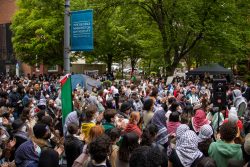Georgetown has agreed to provide the Washington Metropolitan Area Transit Authority with a fuel cell bus to be used on Metrobus routes beginning this spring.
According to a Metro press release, they are currently modifying the bus to make it compatible with Metro transit buses.
Using annual funding from the Federal Transit Administration, Georgetown University’s Advanced Vehicle Development program has developed five fuel cell powered buses over the past 20 years.
In an attempt to address environmental concerns about the use of petroleum for fuel, Georgetown sends the buses all over the country to demonstrate fuel cell technology.
The buses run on liquid methanol and can be refueled at a tank with a pump just like a standard transit bus. According to James T. Larkins, the program manager of AVT, the buses can travel 300 to 350 miles before refueling.
Although the University lacks an engineering department, it recieves funding each year from the FTA to develop fuel cell technology. Since the program’s inception in 1983, the University has received an estimated $44.5 million dollars.
According to Larkins, Georgetown was in a good position to have such a program due to its desire to develop fuel cell technology.
“This program started when the university was looking for fuel cells as an energy source on campus. We also had a bus fleet, which gave the University an advantage,” Larkins said.
The AVD program, staffed by four engineers, currently has five fuel cell buses. Three of these buses are 30 feet long and two, the newer ones, are 40 feet long.
One of the 30-foot buses is currently in use at the University of Florida, while another is waiting at the University of Maryland to be shipped to University of California, Davis. The third of the 30 foot buses can be found on campus, where it is used for back-up testing and demonstration. According to Larkins, students are not able to ride the bus.
The fuel cell program, which began in 1983, grew larger in 1993 when the 40-foot buses were added. One 40-foot bus is currently in Palm Springs, where it will be used for testing and demonstration on the West Coast.
The bus is in Palm Springs “just to let people see how this technology will help them in the future,” Larkins said.
When the buses run, they go as fast and accelerate as quickly as standard transit buses. The fuel cells take up room that would normally be reserved for extra seating, so the buses have a slightly lower capacity.
Larkins said that because of its research into fuel cell power, Georgetown is at the forefront of fuel cell technology.
“This University has as much knoweldge as any other organization in the country about buses and fuel cells. By the time we got to the 40-foot program, no other organization had the background that we did on buses and fuel cells,” he said.




